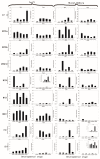Tissue-Specific Expression Analysis of Anthocyanin Biosynthetic Genes in White- and Red-Fleshed Grape Cultivars
- PMID: 26703539
- PMCID: PMC6331842
- DOI: 10.3390/molecules201219883
Tissue-Specific Expression Analysis of Anthocyanin Biosynthetic Genes in White- and Red-Fleshed Grape Cultivars
Abstract
Yan73, a teinturier (dyer) grape variety in China, is one of the few Vitis vinifera cultivars with red-coloured berry flesh. To examine the tissue-specific expression of genes associated with berry colour in Yan73, we analysed the differential accumulation of anthocyanins in the skin and flesh tissues of two red-skinned grape varieties with either red (Yan73) or white flesh (Muscat Hamburg) based on HPLC-MS analysis, as well as the differential expression of 18 anthocyanin biosynthesis genes in both varieties by quantitative RT-PCR. The results revealed that the transcripts of GST, OMT, AM3, CHS3, UFGT, MYBA1, F3'5'H, F3H1 and LDOX were barely detectable in the white flesh of Muscat Hamburg. In particular, GST, OMT, AM3, CHS3 and F3H1 showed approximately 50-fold downregulation in the white flesh of Muscat Hamburg compared to the red flesh of Yan73. A correlation analysis between the accumulation of different types of anthocyanins and gene expression indicated that the cumulative expression of GST, F3'5'H, LDOX and MYBA1 was more closely associated with the acylated anthocyanins and the 3'5'-OH anthocyanins, while OMT and AM3 were more closely associated with the total anthocyanins and methoxylated anthocyanins. Therefore, the transcripts of OMT, AM3, GST, F3'5'H, LDOX and MYBA1 explained most of the variation in the amount and composition of anthocyanins in skin and flesh of Yan73. The data suggest that the specific localization of anthocyanins in the flesh tissue of Yan73 is most likely due to the tissue-specific expression of OMT, AM3, GST, F3'5'H, LDOX and MYBA1 in the flesh.
Keywords: Vitis vinifera; anthocyanin; colour; flesh; gene expression; grapevine; skin; tissue specificity.
Conflict of interest statement
The authors declare no conflict of interest.
Figures



Similar articles
-
Transcriptional control of anthocyanin biosynthetic genes in extreme phenotypes for berry pigmentation of naturally occurring grapevines.BMC Plant Biol. 2007 Aug 30;7:46. doi: 10.1186/1471-2229-7-46. BMC Plant Biol. 2007. PMID: 17760970 Free PMC article.
-
Berry skin development in Norton grape: distinct patterns of transcriptional regulation and flavonoid biosynthesis.BMC Plant Biol. 2011 Jan 10;11:7. doi: 10.1186/1471-2229-11-7. BMC Plant Biol. 2011. PMID: 21219654 Free PMC article.
-
Anthocyanin biosynthesis is differentially regulated by light in the skin and flesh of white-fleshed and teinturier grape berries.Planta. 2016 Jan;243(1):23-41. doi: 10.1007/s00425-015-2391-4. Epub 2015 Sep 3. Planta. 2016. PMID: 26335854
-
Flower colour and cytochromes P450.Philos Trans R Soc Lond B Biol Sci. 2013 Jan 6;368(1612):20120432. doi: 10.1098/rstb.2012.0432. Print 2013 Feb 19. Philos Trans R Soc Lond B Biol Sci. 2013. PMID: 23297355 Free PMC article. Review.
-
Advances in table grape breeding in Japan.Breed Sci. 2016 Jan;66(1):34-45. doi: 10.1270/jsbbs.66.34. Epub 2016 Jan 1. Breed Sci. 2016. PMID: 27069389 Free PMC article. Review.
Cited by
-
De novo transcriptome sequencing of radish (Raphanus sativus L.) fleshy roots: analysis of major genes involved in the anthocyanin synthesis pathway.BMC Mol Cell Biol. 2019 Oct 23;20(1):45. doi: 10.1186/s12860-019-0228-x. BMC Mol Cell Biol. 2019. PMID: 31646986 Free PMC article.
-
Genetic architecture of anthocyanin pigment traits and purple spot (Stemphylium vesicarium) resistance in an F1 pseudo-testcross population of asparagus.Plant Genome. 2025 Jun;18(2):e70028. doi: 10.1002/tpg2.70028. Plant Genome. 2025. PMID: 40204667 Free PMC article.
-
Coordinated Regulation of Anthocyanin Biosynthesis Genes Confers Varied Phenotypic and Spatial-Temporal Anthocyanin Accumulation in Radish (Raphanus sativus L.).Front Plant Sci. 2017 Jul 19;8:1243. doi: 10.3389/fpls.2017.01243. eCollection 2017. Front Plant Sci. 2017. PMID: 28769952 Free PMC article.
-
Artificial shading of teinturier grape Kolor clusters reveals light-responsive biomarkers: focus on flavonoid profiles and metabolism.Front Plant Sci. 2024 Mar 12;15:1356799. doi: 10.3389/fpls.2024.1356799. eCollection 2024. Front Plant Sci. 2024. PMID: 38533403 Free PMC article.
-
R2R3-MYB Transcription Factors Regulate Anthocyanin Biosynthesis in Grapevine Vegetative Tissues.Front Plant Sci. 2020 May 7;11:527. doi: 10.3389/fpls.2020.00527. eCollection 2020. Front Plant Sci. 2020. PMID: 32457776 Free PMC article.
References
-
- Santiago J.L., Gonzalez I., Gago P., Alonso-Villaverde V., Boso S., Martinez M.C. Identification of and relationships among a number of teinturier grapevines that expanded across Europe in the early 20th century. Aust. J. Grape Wine Res. 2008;14:223–229.
-
- Gomez C., Conejero G., Torregrosa L., Cheynier V., Terrier N., Ageorges A. In vivo grapevine anthocyanin transport involves vesicle-mediated trafficking and the contribution of anthoMATE transporters and GST. Plant J. Cell Mol. Biol. 2011;67:960–970. doi: 10.1111/j.1365-313X.2011.04648.x. - DOI - PubMed
Publication types
MeSH terms
Substances
LinkOut - more resources
Full Text Sources
Other Literature Sources
Molecular Biology Databases
Research Materials
Miscellaneous

